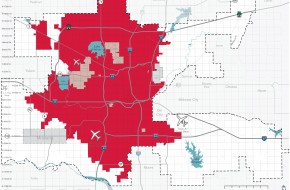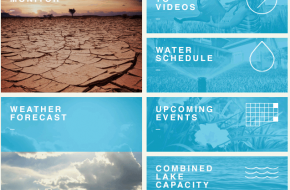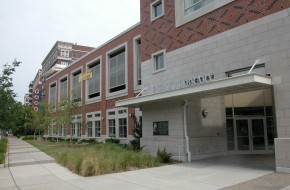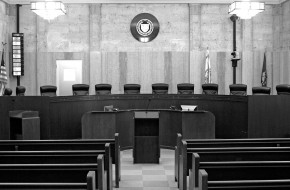Initiatives
Each initiative below summarizes and explains related policies the City and its partners will pursue in order to accomplish goals related to public services. Click on the initiatives below to view full explanations and related policies.
We will incorporate crime prevention principles into the City’s design regulations and guidelines. Previous elements of the plan, including playokc and liveokc, introduced the concept of Crime Prevention Through Environmental Design principles (CPTED), which use common-sense design features to minimize opportunities for criminal activity. CPTED principles apply on a wide range of scales, from individual site vegetation choices to citywide development patterns.
Oklahoma City should incorporate CPTED principles into its design standards for development and redevelopment of public and private projects. Some cities (including Wichita, Kansas) have established ordinances that officially integrate CPTED principles into their design standards, while others use them as guidelines and adapt for their own use.
The City can encourage the use of CPTED principles through:
- Encouraging land use planning that mixes uses and extends hours of activity and “eyes on the street.”
- Establishing neighborhood territoriality by which adjacent residents and businesses can monitor activity in the public realm. a mixture of uses in neighborhoods.
- Lighting and building design guidelines.
- Landscaping guidelines that avoid hidden places.
- Building code enforcement and resolution and elimination of chronic vacancy and structural deterioration.
The City’s project review and approval process should include Police Department participation to provide specific public safety recommendations. The department should maintain an officer on staff with a specialty in CPTED and its principles. This staff member should also provide outreach to the development community to provide special training to builders, developers, and design professionals on safe community design.
Click to expand policy information.
Create a standards for trails based on industry standards, “Crime Prevention Through Environmental Design” principles, expected use, and surrounding land uses.
Establish access management requirements that limit driveways on arterials and collectors and increase connections between uses to improve safety and traffic efficiency.
Limit driveways on arterials and collectors and increase connections between uses to improve safety and traffic efficiency.
Ensure proper access to and between subdivisions in order to offer a choice in routes for residents, multiple access points for emergency responders, and to reduce vehicle congestion at arterial intersections. Contiguous developments should share access whenever feasible.
Establish a process for existing neighborhoods to request traffic calming, including how to evaluate the request, select the appropriate type of calming treatment, and fund recommendations.
Require sidewalks on both sides of all streets in urban LUTAs and in the Rural Residential LUTA for subdivisions with densities greater than 1 unit per acre.
Target specific areas of the city for enhanced safety and proactive enforcement. Selection of target areas will be informed by the Intelligence Led Policing program, with coordinated involvement from Police, Code Enforcement, Public Works Department, Planning, and community-based organizations.
Establish a Crime-Free Multifamily Housing Program designed to keep multifamily housing developments safe from crime and perceptions of crime by:
- Supporting partnerships between the police, property managers, property owners, and tenants.
- Providing training to managers and owners about screening applicants, fire safety, fair housing, and other components of ‘active property management’.
- Providing a security assessment based on Crime Prevention Through Environmental Design (CPTED) principles.
- Conducting safety meetings with residents/tenants.
Ensure that safety is factored into the design of neighborhoods through the following policies:
- Incorporate development standards and guidelines into the Subdivision Regulations that integrate the principles of Crime Prevention Through Environmental Design (CPTED) and increase safety and social interaction.
- Create a pre-development checklist with criteria to evaluate how safety is designed into a project.
- Establish a pre-development process wherein safety is considered in the design of projects.
- Involve the Fire and Police Departments in reviewing proposed development and redevelopment to provide input on any safety-related design concerns.
Establish criteria for locating, designing, and improving public and private parks to enhance safety and security, including:
Locating new parks in areas that are highly visible and accessible from surrounding residential streets and utilize trails to increase activity and visibility in parks.
Utilizing Crime Prevention Through Environmental Design principles, which includes controlled access, visibility, lighting, etc. for new parks and retrofitting/redesign of existing parks.
Improve safety of users of the parks and trails system by:
- Providing good lighting, emergency call boxes, and regular police patrols along the trail system.
- Providing shelter structures along the trail networks and determining the appropriate spacing for such structures. Structures could be relatively small to keep costs down but should be sturdy and easy to maintain.
Incorporate Crime Prevention Through Environmental Design (CPTED) principles into city-wide design standards for development and redevelopment of public and private projects. CPTED principles include: 1) Territorially – physically define spaces as public or private and the appropriate use is obvious even to outside observers; 2) Access Control – deny access to soft targets; 3) Natural Surveillance – make it easy to observe all users of/in a particular territory/space; 4) Maintenance and Management – ensure equipment is functioning (lights, gates, etc.), landscape is kept neat especially to preserve surveillance.
Maximize fire safety through actions such as:
Modifying regulations and guidelines to prevent subdivisions with a single point of access – except those with fewer than 10 homes.
Developing a vegetation management program targeting the wildland/urban interface, including rights-of-way in rural areas, and incorporating recommendations from the National Fire Protection Association’s Firewise Communities initiative.
Requiring residential sprinklers for developments located in Rural Land Use Typologies.
Requiring exceptional, effective, and easy access to sites augmented by a thorough system of connections within and between developments.
Evaluate development proposals to assess design components that contribute to or detract from safety and analyze emergency response capacity and capability.
Ensure that planokc is periodically updated to coordinate/correspond with the City’s Emergency Operation Plan and vice versa.
Adopt design standards to enable emergency management resources to be highly effective, such as resilient buildings, interconnected transportation networks, and other design considerations that help ensure community safety and recovery.
Encourage the integration and mixing of land uses in urban areas.
In order to promote compatibility between different uses, establish standards and guidelines that ensure all developments are pedestrian-friendly and human scale at street frontages and property lines.
2: Increase partnerships between police and communities to minimize conditions that encourage crime.
We will implement cooperative programs with neighborhoods that both build local trust and engage and redirect at-risk youth. Public safety partnerships begin by working with neighborhoods to address and remove signs of neglect and alienation, both in the physical and human environments. It continues with building on the natural allegiances between a police department whose commitment is to protect and serve its citizens and citizens who need the security of safe neighborhoods to live and prosper. Finally, and perhaps most importantly, it involves the creativity and imagination to see young people as potential leaders rather than potential criminals. People often live up or down to expectations. Youth should be engaged in the process of becoming leaders, improving themselves and their neighborhoods. Law enforcement officers, in partnership with other organizations, are in an ideal position to lead that process.
Click to expand policy information.
Enhance effective policing by:
- Developing and/or enhancing community policing programs, which involve residents and businesses in crime prevention strategies.
- Increasing business presence and participation in community policing.
- Improving public outreach.
- Increasing opportunities for the Oklahoma City Police Department community relations officers to interact with community organizations, neighborhoods groups, schools, recreational and/or athletic programs. This interaction should include increasing resources to allow real-time communication of safety concerns with these organizations.
Seek funding, sponsors, and partnerships to enhance and expand the following crime prevention strategies:
- Education and job training for at-risk youth.
- Community involvement programs such as Light Up The Night, Neighbors Night Out, and other similar activities and programs designed to strengthen neighborhoods.
Target specific areas of the city for enhanced safety and proactive enforcement. Selection of target areas will be informed by the Intelligence Led Policing program, with coordinated involvement from Police, Code Enforcement, Public Works Department, Planning, and community-based organizations.
Create partnerships and programs involving civic groups, business organizations, governmental entities, coalitions, and non-profits to develop or enhance the following:
- School reading programs;
- Elementary school intramural sports leagues;
- Rehabilitation of school infrastructure and replacement of school equipment (athletic facilities, media center materials, computers, etc.);
- After-school programs that focus on mentoring or conflict resolution;
- Rehabilitation of City parks;
- Community involvement opportunities associated with public schools; and,
- Other projects or programs that improve neighborhood safety by working with children.
Quickly repair damage caused by vandalism, including graffiti, to minimize negative impacts on neighborhoods. Coordinate the efforts of existing programs, such as the Police Department’s Removal Unit, the Public Works Department’s Removal Unit, and Oklahoma County’s “SHINE” program to increase responses in targeted areas and expand the area which can be covered. Increase participation by the business community, such as donations of paint and time.
Establish a Crime-Free Multifamily Housing Program designed to keep multifamily housing developments safe from crime and perceptions of crime by:
- Supporting partnerships between the police, property managers, property owners, and tenants.
- Providing training to managers and owners about screening applicants, fire safety, fair housing, and other components of ‘active property management’.
- Providing a security assessment based on Crime Prevention Through Environmental Design (CPTED) principles.
- Conducting safety meetings with residents/tenants.
Ensure resources and funds remain dedicated to crime prevention programs, including but not limited to: block watches; graffiti removal; education and outreach associated with elder fraud, identity theft, and sexual predators; safe driver programs for automobiles, motorcycles, and bicycles; after-school and youth diversion programs that provide recreational and educational support (tutoring, homework help, etc.); and other crime prevention programs. Ensure planokc is maintained to support and reflect the City’s priorities to provide a safe and secure community.
Reinforce existing partnerships and create new partnerships with allied agencies and non-profits to intervene early and often with at-risk youth redirecting them from participation in criminal activities to educational opportunities, job training, community service projects, neighborhood and business improvement programs, and other community building projects and/or programs.
Seek ways to improve efficiency of positions in the Police Department, such as directing responsibility for analyzing and proactively addressing crime from uniformed officers to trained analysts.
Reduce crime and improve feelings of safety through long term efforts such as:
- Improving design regulations to maximize crime prevention through appropriate urban design,
- Developing community-based activities, programs, and facilities that reduce crime and develop life skills, such as after school and youth diversion programs and facilities for recreation and educational support (e.g., tutoring, homework help, etc.),
- Encouraging more compact development to increase effectiveness of individual officers by ensuring less travel time and more engagement,
- Implementing a “good landlord” program,
- Exploring enhancements to police operations such as:
- Committing to a certain number of officers per capita and/or per square mile of urbanized area,
- Increasing patrols (automobile, bicycle, or on foot) in targeted areas,
- Evaluating needs on a regular basis for increasing the number of key positions, such as detectives, to meet demands,
- Coordinating neighborhood improvement efforts (such as the Strong Neighborhoods Initiative and the Vacant and Abandoned Buildings program) with policing efforts, and
- Supporting efforts to obtain more effective criminal justice law, such as stricter gang laws.
We will implement land use and design policies that reduce the probability of loss of life and property and expedite response and reconstruction. Emergencies are inevitable and can never be fully prevented. But we will pursue a coordinated program to reduce their probability from avoidable causes and respond effectively when they do occur. We can reduce the probability of emergencies by building code revisions that limit threats from fire, weather, and other disasters; manage vegetation to reduce flammable vegetation around buildings and where urban and rural environments meet; and implementing the recommendations of the Oklahoma City Hazard Mitigation Plan (2012). Some high priority mitigation measures recommended by the plan include construction of safe-rooms and storm shelters, enhanced warning systems for potential hazards, regulation of development in the floodplain, and better stormwater management.
Once emergency situations occur, quick response and rapid access become critical. A well connected transportation network promotes efficient emergency response by providing multiple route options and shorter travel distances between emergency sites and service providers. In catastrophic disasters like floods and tornados, an interconnected street network provides alternative ways in and out of affected areas. Just as the development review process must address public safety through CPTED standards, it should also address fire safety and emergency response criteria, using available sources like the National Fire Protection Association’s Firewise Communities.
Click to expand policy information.
Revise subdivision regulations to include connectivity standards and guidelines that require greater street connectivity, and provide allowances for pedestrian and bicycle connections when street connectivity cannot be made.
Prioritize opportunities to restore and reconnect the street grid.
Change subdivision regulations to determine the number of entries into a residential development based on number of lots in order to improve connectivity of the roadway network and emergency response.
Support the creation of a regional transit authority and pursue the establishment of a dedicated funding source, such as sales tax or property tax to achieve long term transit service goals.
Maximize fire safety through actions such as:
Modifying regulations and guidelines to prevent subdivisions with a single point of access – except those with fewer than 10 homes.
Developing a vegetation management program targeting the wildland/urban interface, including rights-of-way in rural areas, and incorporating recommendations from the National Fire Protection Association’s Firewise Communities initiative.
Requiring residential sprinklers for developments located in Rural Land Use Typologies.
Requiring exceptional, effective, and easy access to sites augmented by a thorough system of connections within and between developments.
Evaluate development proposals to assess design components that contribute to or detract from safety and analyze emergency response capacity and capability.
Adopt design standards to enable emergency management resources to be highly effective, such as resilient buildings, interconnected transportation networks, and other design considerations that help ensure community safety and recovery.
Require all new utility lines to be buried and bury existing utility lines when possible (e.g., when roads are widened).
We will provide City services in areas that create the most benefit for dollar spent and where market demand exists. New services should be provided in areas of the city are the most efficient to serve considering both operating costs and capital investments. In many cases, this will involve incremental infrastructure extensions in contiguous areas, or where a new drainage basin can be opened in areas where market demand and city growth goals coincide. Possible sources to demonstrate market demand include housing demand studies, employment land studies, retail strategies, land supply analyses, and system-wide study for specific services. The findings from these market studies should be incorporated into planokc and used to inform General Obligation bonds, Capital Improvement Projects, and the land use plan.
Public financing is a particularly important instrument for directing growth. In general, public financing should be directed to areas that promote planokc’s overriding goal of healthy and sustainable development. For example, extending a strategic interceptor sewer that opens a basin to development may receive front-end public financing through revenue bonds.
When developing new areas, the City should ensure that services can support new development without diminishing service to existing neighborhoods. For example, the need to extend water to new development should not jeopardize the availability of fire suppression flow in existing neighborhoods.
We will use municipal utilities and services as catalysts to leverage neighborhood revitalization and redevelopment. Investments in infrastructure and City facilities support revitalization efforts by both targeting and preparing key areas for redevelopment. Improvements to infrastructure and City services should be correlated with redevelopment efforts, in order to provide accurate information to the private market regarding preferred land use locations, uses, and intensities.
Click to expand policy information.
Locate, design and upgrade City facilities and infrastructure in a manner that supports neighborhood revitalization and redevelopment.
Provide adequate infrastructure for new or expanding companies by giving priority to Capital Improvements in ER areas. Additionally, consider the implementation of impact fees for infrastructure in order to provide infrastructure in a timely manner and to better coordinate with private development.
Ensure adequate funds to maintain enhanced levels of service (including staffing) in places that have been or will be designated as special districts.
Prioritize and concentrate development where facilities, infrastructure, and services have capacity and in areas where the Police and Fire Departments are best able to respond. Guide the location and timing of development through the proactive and strategic installation of infrastructure.
Use one or more of the following methods to ensure infrastructure and facility capacities are adequate for proposed development:
- Ongoing master planning to determine the necessary water, sewer, and road infrastructure to serve development.
- An impact fee system that collects funds for specific areas as they develop and installs needed infrastructure in a timely manner.
- Use of special service districts to ensure appropriate levels of service, sufficient revenue, and timely installation of infrastructure and facilities for each district.
- Require developers to construct or fully fund infrastructure or other improvements needed to serve their development, with reasonable accommodation for future adjacent or nearby development.
- Require developers to wait until the City (or the State as the case may be) constructs the infrastructure needed to serve their development.
- For development proposed in areas not currently within one-half mile of existing water infrastructure, require a service area study to first be completed to determine the best method for providing water to the service area.
For development proposed in areas not currently within a sanitary sewer drainage basin, a drainage basin study should first be completed to determine the best method for sanitary sewer service.
Create and implement small area plans for neighborhoods or districts with special strategic importance or complications related to development or redevelopment.
We will plan for mid- to long-term solid waste service. The City should contribute to the development and completion of the long-range solid waste study and incorporate applicable recommendations and policies into planokc. A key element of the study should be addressing future landfill needs, with existing landfills scheduled for completion between 2022 and 2026. The study should consider whether service is best provided by private operators or municipal or regional entities. It should also address strategies to prolong the life of existing and future fills by reducing the waste stream.
We will encourage residents to divert waste from landfills. The City should implement aggressive programs to expand participation in recycling programs. These efforts should assess and improve the convenience of programs, making it as easy as possible for customers to participate on a routine basis; expand public relations and educational efforts on the benefits of recycling and the cost savings that can accrue to taxpayers. A waste reduction program should also coordinate with the county extension offices and neighboring jurisdictions to improve public outreach efforts about the benefits of backyard composting. Diverting recyclables and compost materials from the waste stream will lessen the strain on our landfills.
Click to expand policy information.
Upon the completion and adoption of the long-range solid waste flow and disposal plan, use any applicable recommendations to update planokc.
Coordinate with the county extension offices and neighboring jurisdictions to improve the public outreach campaign about the benefits of backyard composting.
We will achieve a significant reduction in the amount of water used per person. Water is not overly abundant in the Oklahoma City area and the effects of climate change are uncertain, but not likely to produce more annual rainfall. Therefore, it is likely that at best, obtaining water will become more difficult and rates will increase. Water conservation is a positive good to everyone and steps should be taken to stretch our resources. To this end, the City should identify and remove regulatory barriers related to such water conservation measures as rainwater harvesting, gray water irrigation, and other re-use strategies and practices. Public education programs should identify areas of unnecessary water usage and provide citizens with information on how to reduce individual usage.
The City can also lead the water conservation cause by example, by reducing potable water consumption at City facilities, such as City Hall or recreation facilities. Water conservation can be promoted through a combination of user education and facility modifications, such as installing low flow faucets.
Click to expand policy information.
Revise the landscape ordinance to include the following:
- Define terms such as invasive species, exotic/non-native species, and native/indigenous species
- Require removal of invasive species from existing sites, and prohibit such species from being planted or maintained in new development.
- Provide a reference list of native plants and drought-tolerant plants.
- Provide incentives for using native and drought-tolerant plants and disincentives for using high-water plants and turf grass.
- Establish requirements for using design practices that minimize the need for supplemental irrigation.
Establish strategies, procedures and policies for City construction projects to achieve higher energy efficiency, including:
- Implementing an energy management plan for City facilities.
- Monitoring energy consumption of City facilities, tracking conservation progress, and communicating results to City administrators, employees, elected officials and the public.
- Assessing water use in City facilities to identify opportunities for conservation and implement appropriate measures.
Develop an enforcement mechanism for the City’s Building Energy Code. Develop a healthy building code to support construction of durable, health-promoting and energy efficient buildings that incorporate proven green development practices, locally-sourced and environmentally responsible materials, water conservation fixtures, innovative design and construction techniques, and low waste construction practices. Incentivize their use with shorter approval procedures, priority permits and inspections, and reduced fees.
Identify and remove barriers related to water conservation practices, including rainwater harvesting, graywater irrigation, treated effluent re-use practices, and others.
Develop an inventory of water uses at City facilities. Identify opportunities to reduce water use while sustaining service levels to the public. Implement the most prudent opportunities.
We will coordinate library service planning with investments in City facilities and neighborhood planning. Oklahoma City should partner with the Metropolitan Library System and the State Department of Libraries to coordinate facility expansions, improvements, and new facility locations with other types of civic investments, such as schools, fire stations, and parks. This could allow for efficiencies through facility sharing or co-location.
New and remodeled libraries should support neighborhood planning goals by integrating themselves into their surroundings. The City should adopt design standards for both new and remodeled libraries that focus on integrating the building and site into the surrounding neighborhoods, thus increasing access to the libraries by walking, biking, and transit.
Click to expand policy information.
Form a working partnership with the library system, both the Metropolitan Library System and the Oklahoma Department of Libraries, to coordinate timing of facility expansions, improvements, and new facility siting with other types of civic resources, such as schools, fire stations, parks, and projected growth and demand for those resources. This should also include identifying a mechanism to provide library services in Canadian County.
Adopt design standards applicable to both new and remodeled libraries focusing on integrating the building and the site into existing neighborhoods and urban fabric, reducing their dependence on automobiles and increasing their access by other modes, especially walking, biking, and transit.
We will form partnerships and implement efforts that create settings that advance educational achievement. The challenges facing Oklahoma City’s public education system are daunting. The stakes of success are great, given the need to capitalize on the potential of our youth and the importance of quality schools in achieving this plan’s overall goals. School policy and curriculum are far beyond the scope of planokc. But City policy can help provide safe and nurturing environments that remove at least some of the pressures and distractions that keep kids from learning. Both this element and liveokc address people’s expectation to live in safe neighborhoods.
The City’s Strong Neighborhoods Initiative (SNI) program, for example, can establish recreational, fire safety, public safety, and character building programs for schools. This program to create supportive environments includes initiatives discussed in previous elements – parks and recreational programs, neighborhood development, stabilizing social fabric, and many others. Direct partnerships with schools can also be extremely effective. The City can initiate strong connections between schools and the business community to improve education, training, and retraining. Finally, a city that includes 27 school districts and has helped fund projects in many of them can help initiate regional cooperation and some sharing of responsibilities.
Click to expand policy information.
Facilitate communication among the 23 school districts in order to develop more arts education opportunities for the children in our community.
Incorporate preventive health care and wellness education into public schools, recreation centers, senior centers, and technical/trade schools.
Establish a working partnership between the City, Oklahoma City Public Schools, Putnam City Schools, Western Heights Schools, and other metro area school districts and educational entities to help school districts complete a variety of non-educational (or indirectly educational) functions such as planning for and siting new schools, working on shared use issues, and redeveloping closed schools. The partnership should coordinate efforts to seek funding and appropriate resources to accomplish the following:
- Establish multiuse recreational and exercise facilities in schoolyards to increase opportunities for physical activity and strengthen the relationship between schools and neighborhoods.
- Establish a program to increase the number of community members and schools that make effective use of Senate Bill 1882 (effective 11/1/2012) allowing shared use of school facilities for recreational purposes.
Coordinate with Strong Neighborhoods Initiative to provide recreational, fire safety, public safety, and character building programs in schools.
Identify ways to establish/strengthen relationships and partnerships between schools and the business community as one method to improve student education and outcomes.
Support diverse and high-achieving student bodies through the creation of mixed-income neighborhoods that encourage parental and community involvement by:
- Integrating home sizes and types at neighborhood and block scales,
- Avoiding concentrations of low-income households by encouraging income diversity within neighborhoods and by spending City housing funds in a manner that does not concentrate low income households in one development or neighborhood, but instead creates opportunities for these households to live in income-diverse neighborhoods, and
- Encouraging school districts to open schools and school grounds after school hours to support community engagement and more convenient opportunities for active recreation.
We will develop and distribute educational programs that increase public understanding of animals in the city. The City can promote animal welfare through public education programs that help the public understand how to deal with stray animals. Continued support of the animal shelter and its related programs can help rescued animals find the permanent homes they need.
Click to expand policy information.
Improve communication and public outreach about stray animals such as safe handling practices and who to call for help, including after-hours.
Enhance programs, such as Community Cats, Foster Program, and the Community Pets Spayed and Neutered Program designed to help rescued animals find permanent homes.
We will establish internal systems and referrals that maximize efficiency in providing public service. In all of its operations, the City should take steps that maximize staff efficiency. Many of these steps are relatively easy to accomplish. For example, providing public information and working with neighborhood organizations can help channel items such as code enforcement complaints to the proper department, rather than Police and Fire Departments, who do not have jurisdiction over this service. Coordination between utility providers as infrastructure is installed can save both time and money, and eliminate misdirection and duplication of efforts. Services that Oklahoma City provides to other jurisdictions by contract should be fully self-supporting to prevent unintended subsidization by City taxpayers. These and other efficiencies can save money, provide better service, and produce more satisfaction on the part of both staff and customers.
Click to expand policy information.
Seek opportunities to co-locate new public projects, such as libraries, fire stations, parks, and recreation centers near compatible civic uses such as schools and campuses to create nodes of activity and services.
Reuse brownfield, greyfield, and other vacant building sites to provide new opportunities for mixed-used and mixed-income housing.
Catalyze the rehabilitation of abandoned structures by amending codes to facilitate the adaptive reuse of existing buildings for residential use.
Develop a City program to rehabilitate or redevelop dilapidated properties, including a land bank to receive donated properties from property owners who can no longer maintain their properties.
Use established mechanisms/tools to allow property owners to provide for the perpetual maintenance, repair and reconstruction of private roads, sidewalks, trails, utilities, and parks in new housing developments by requiring funding mechanisms such as:
- Maintenance bonds/escrows
- Special assessment districts, such as Business Improvement District or Special Improvement District
- Covenants requiring compulsory membership in an incorporated Property Owners Association whose members will be financially liable for any such maintenance, repair, or reconstruction costs.
Incorporate these financing options into the platting process (or zoning process in the case of PUDs).
Construct all private roads and utilities to comply with minimum design and paving standards as outlined in the City of Oklahoma City Subdivision Regulations, including those related to the appropriate Street Typology.
Evaluate public facilities and public property for unsafe conditions such as poor lighting (quality and quantity); blind spots; poor maintenance conditions; and other unsafe conditions. Prioritize improvements to these facilities and properties based on the following criteria: a) Proximity and condition of nearby neighborhoods; and b) Cost/benefit associated with mitigating the unsafe condition and maintaining the improvement.
Form a working partnership with the library system, both the Metropolitan Library System and the Oklahoma Department of Libraries, to coordinate timing of facility expansions, improvements, and new facility siting with other types of civic resources, such as schools, fire stations, parks, and projected growth and demand for those resources. This should also include identifying a mechanism to provide library services in Canadian County.
Enhance programs, such as Community Cats, Foster Program, and the Community Pets Spayed and Neutered Program designed to help rescued animals find permanent homes.
For projects involving City rights-of-way, require a coordinated approach to utility work, installation, upgrades, etc. – including water, sewer, stormwater, communications, electricity, and gas – as it pertains to placement, timing, and maintenance. Consider establishing major utility corridors to facilitate this coordination and to signal tangible support for increased development in specific areas throughout the city.
Support annexation or deannexation actions that improve City service efficiency; improve fiscal sustainability; and/or contribute to regional goals related to transportation systems or environmental resources.
Locate, design and upgrade City facilities and infrastructure in a manner that supports neighborhood revitalization and redevelopment.
Improve efficiency of City operations through the following means:
- To the extent possible, base fees and charges on the cost of services and goods provided depending on location.
- Investigate and implement technological approaches to improving local government efficiency and service quality.
Provide public services in the most cost-effective manner through efficient growth by:
- Implementing an impact fee structure that varies by district according to actual cost.
- Studying the impacts of altering the pricing of utilities to factor in how the location of a user impacts the cost of providing them utility services.
- Exploring the use of fee-based revenue methods for maintaining infrastructure, such as transportation facilities, utility systems, and other public infrastructure.
- Altering zoning ordinance and subdivision regulations to allow more efficient development patterns.
























 Download PDF
Download PDF




